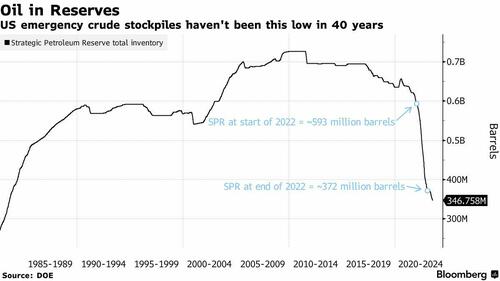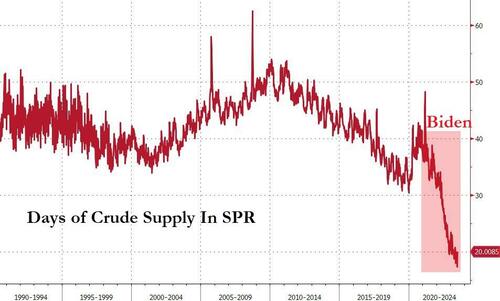While it took the Biden administration the better part of six months to drain the US oil supply down to a precarious 20-days of emergency reserves (a 40-year low), it will take decades to refill – if that happens at all, Bloomberg reports. (h/t: Zerohedge)
Thanks to the Biden administration, these reserve sites are sitting half empty. This is not a good situation to be in, especially if Biden plunges us into war as seems to be his intention.
The Strategic Petroleum Reserve (SPR) now sits at 346.8 million barrels – a level unseen since 1983 – out of a total authorized storage capacity of 714 million.

Perhaps even more noteworthy, the emergency reserves are equal to approximately just 20 days worth of supply – an all-time record low…

Replenishing the supply will be a nontrivial and lengthy process according to experts, who say that a lack of funding and ancient infrastructure will hinder the process, despite the Energy Department’s vow to keep buying.
Now that energy costs are back down comes the task of refilling the reserve. That will be a complicated, expensive process. Oil prices are now much higher than when most of the inventory was originally bought — the average price paid for oil in the reserve was $29.70 per barrel, which compares with the current benchmark cost for US crude futures at about $75.
And there’s the balance between needing to buy and not purchasing too much at once, lest the oil market gets spooked and prices jump higher.
“It would be a very slow process even if you had the money and the facilities were are all in good shape,” said John Shages, who previously oversaw the oil cache for the Energy Department, adding “It could take decades.”
Energy traders watching the White House buy barrels of oil back to refill the strategic reserve pic.twitter.com/xRFGEx8g5F
— Kenny Lay (Parody) (@EnronChairman) July 10, 2023
The depleted SPR also means that the US could be vulnerable to oil price shocks. In particular, during domestic supply crunches, America will be left to the mercy of the Saudis, Russia and the rest of the OPEC+ cartel.
They won't make it past a month in the SPR
— Julie Wade (@julie_wade) July 17, 2023
Transportation is the segment that will be affected.
We won't be flying or driving during this time, prices will be astronomical. pic.twitter.com/6arYZdV92f
Salt caverns
The Gulf Coast salt caverns that make up the reserve were initially designed with a 25-year lifespan. As such, the risk of cavern dissolution increases with each drawdown and refill. Maintenance issues, along with the ballooning costs of the $1.4 billion modernization program, add further strain to the already troubled reserve.
